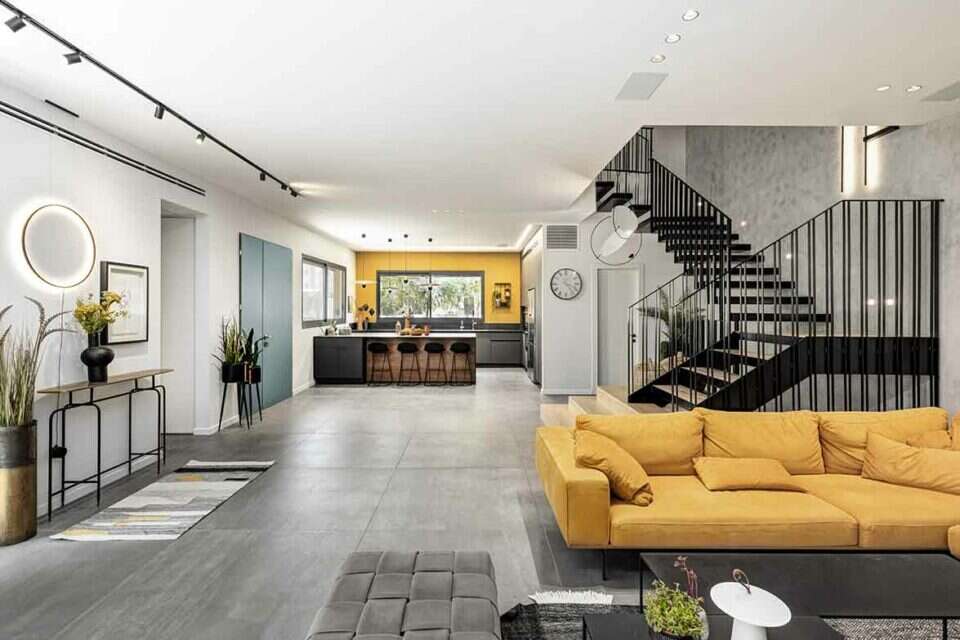The upcoming Tishrei holidays are a time of new beginnings, and an excellent time to stir up thoughts about redesigning the spaces of the home.
The design stores already prepare every year for the "three habits" of upgrading the Israeli home.
It's just that this year the prices of construction work and renovations, as well as the prices of furniture and related accessories, have risen dramatically.
For many, the dream of the perfect dream house has completely disappeared.
In a situation where you have to compromise and give up, it is more important than ever to act with care and consideration.
There is nothing wrong with concessions, as long as they are made with a clear mind in order to avoid a host of disappointments, frustrations, and not on us - unnecessary financial entanglements.
But how do you even begin, when the list of needs and requirements is long and getting longer?
Let's start at the beginning.
Most of the renovators formulate for themselves over the years needs that can be called "imagined".
It is not meant that they are not applicable for good money, but that they simply have nothing to do with the real and immediate needs of the household members.
"Imagined needs" we meet every day in friends' houses that have just finished renovation, in the TV series, in graceful images on design websites or in advertisement videos.
The goal is to market the "right" lifestyle to us.
The only question is - to whom?
Probably not necessarily for you personally.
carpet of carpet wool,
It's a well-oiled machine that "reinvents" the wheel every season.
If you were marketed 80x80 tiles a year ago, the following year you will be marketed 90x90 tiles, and next year they will be tiles of different geometric shapes and varying cuts.
If the kitchens were sold in a certain finish this year, they will be sold next year in a slightly different range of colors and finishes.
It seems that there is really nothing to do with the quality of the appearance of your home, but with the whims of the changing fashion in the world;
And fashion, as we know, is a purely commercial matter.
The kitchen companies, for example, will try to instill in you a feeling that you are ordering the ultimate kitchen, which will look desirable for years.
But the kitchen will look outdated in any case within a short period of time, even if you cook it to perfection.
This is how the rules of fashion work.
This is why aesthetic choices in the spirit of the hottest trend will often cost you more, and will not save you the need to renovate again later.
What's more, super-fashionable choices even tend to "outdated" faster, because of the rate of change of fashion.
The secret: honesty in the process
To some of you, this discussion seems unnecessary.
What's up with you and changing fashions?
It's just that this saying is in itself a fashionable approach today in home design.
If you want a house that has everything you like, without committing to a distinct and distinct design style - you still don't want to live in a mess of furniture and harsh colors.
What, then, defines correct relationships between all parts of the whole into one harmony?
The answer is: the rules of fashion, and again we are back to the beginning.
The eclectic design style that is so common today does not go against the rules of fashion.
It is actually the hottest fashion in the world of design.
So if it seems to you that you "don't count fashion" - get updated.
In the design stores, you meet hundreds of thousands more like you every day.
"Fun Life", Nerlat, by designer Ricky Corey,
All of this, as mentioned, is very confusing, and can greatly undermine the distinction between "real" and "imagined" needs.
So how do you know if what looks "beautiful" also justifies its monetary value, is not a momentary whim and really improves the quality of life at home over time?
The answer in two words: honesty in the process.
Before you storm stores (just to "get ideas"), and even before visiting the repairman (to find out "about how much it will cost"), sit down with yourself.
Think about what you think really needs repair and upgrading, and what your priorities are in life.
yours - and not your friends' or neighbors'.
Do not bother yourself in the first stage with questions of money or logistics.
This stage will also come.
Focus your efforts on defining the right questions, which will lead you as far as possible to honest answers.
Here are examples of questions: How much do you really cook?
And not what will "sound right" to the ears of the designer at the kitchen company, or the architect you hired.
Are you really "hosting a crowd", as the well-worn cliché from the design sections says, or is the house your own little, private piece of God?
What do you do in the bedroom - spend it until the late hours of the morning like in a Spanish telenovela, or is it a room used for sleeping and nothing else?
What really happens in the bathroom?
How long do you stay there, compared to the average length of stay in the salon?
Do the kids bring mud and filth home from kindergarten, or is your living room floor a replica of a Parisian lounge?
Wander like this in your imagination between the rooms of the house, and ask yourself questions.
Write down the answers, because it's important to have them in front of your eyes when you get to the stage of concessions and priorities.
The more honest you are with yourself, the more satisfying the return on the financial investment and expected headache will be.
Now you need to prioritize the needs you defined.
It is obvious that at the top of the list will be the correction and regulation of the infrastructure problems.
A dilapidated water system, unsafe electrical infrastructure, crumbling plaster or cracked reinforced concrete are not something to play with - these are matters that require immediate intervention.
If the budget is enough for repairs only, then you have done the right thing, even if the long-awaited interior design will be delayed a bit.
Minimum movements in the kitchen
After you have checked costs with the renovation contractor, you may be left with an unused budget.
This is where value considerations come into play.
Years of experience show that appropriate conditions in the children's rooms will above all ensure the happiness of the entire family.
This means adequate conditions for sleeping, working, playing.
But again, it has nothing to do with brand names.
The rooms should be clean and painted, and the furniture kept in good condition.
Sometimes all that is needed to change the world is repainting the room, changing the bedding, the carpets and the office chair, and also adding accessories such as curtains, posters, pictures or stickers on the walls.
Make sure the room is well lit.
In many homes, children's rooms are simply dark, which in itself is depressing and uninviting.
It is important to dwell on this, because the Israeli likes to attack his house with heavy hammers.
Sometimes it's just unnecessary, or at least not really necessary.
"Madi" armchair, IDesign, photo: Menachem Oz
Next in order of importance are the kitchen, the living room and the dining area - which in apartments from the past decades are actually one undefined space.
In the kitchen, two generic claims are always repeated: the work surface is not big enough, and there are not enough Epson spaces.
The ultimate goal in any kitchen design is a minimum of unnecessary and tiring movements.
The kitchen stands on three vertices: the sink, the stove and the refrigerator.
The movement between them should be easy, fast and within reach.
Therefore, a kitchen island that requires a body tilt of 180 degrees in the transition between the stove and the sink is much less comfortable than a surface where the transition is continuous on the same plane, or with a 90 degree tilt.
Sometimes there is no choice, but more than once there is a choice - and the choice of an island stems only from a fashionable whim of "imagined" needs.
Also, the distance between the stove and the sink should be "correct".
Meaning - not too big and not too small.
The designers you hire, or the salespeople at the kitchen companies, will be able to expand on this.
Beyond that, work surfaces are required to place various devices.
And again, depends on the amount of equipment you have.
Case by case.
The Epson problems can be solved by using additional cabinets near the kitchen, or in the other rooms of the house.
For example, instead of a casual console as a decoration in the entrance with a vase and dried flowers, place a designed cabinet - and it will also serve as a pantry.
Eating counters are a familiar Epson glutton.
In average apartments, the dining counter (used at best by three undersized diners) is located within touching distance of the dining area.
You can continue to eat cramped on a small stool next to a narrow counter instead of dining in front of a spacious and comfortable table, just keep in mind that the eating counter is not one of the expensive Epson space you so long for.
With the increase in the standard of living and increased consumption comes the demand for huge refrigerators.
In average apartments, it is better to place a refrigerator of a reasonable size in the kitchen for daily use, and back it up with another narrow refrigerator in the closet room or on the service balcony.
Original "Hopping" bed, Hollandia, photo: Public Relations
Where will the sofa be located?
Finishing the kitchen facades is a critical issue from a functional point of view.
If you don't wear silk gloves in the kitchen, stay away from finishes that are scratched and damaged by water and dry strokes, no matter how gracefully displayed or attractively priced.
An aesthetic compromise may be required here, but otherwise - you'll find yourself dragged to change facades in no time.
The design accepted today in residential apartments - of an undefined rectangular space for the use of the kitchen, the dining table and the living room - emphasized the intimacy that existed in the apartments of the past.
There is nothing more "correct" about this conventional configuration.
This is architectural fashion.
On the contrary, the traditional planning according to which there was a clear definition for each space, not to mention the separation of the kitchen from the rest of the house, had enormous advantages.
Suffice it to mention the liberation from the constant need to clean the kitchen, which today is practically another corner in the large living room.
Always prefer to look at the main event at home.
It will give calmness and coziness to the space.
From there all other decisions will be made.
That's it, let's go.
To the life of new beginnings in home design.
The tips of the experts
The tip of Sharon Leshem, director of architects and inspiration at Nirlat:
"The first question that needs to be asked even before you attack the color palette is: What images describe a good feeling at home for you. Talk about feelings, and not the names of trends. For example, do you want a house that radiates Warmth and solidity or rather bold and extroverted? This is where the color scale will be derived. Broadly speaking, the powder and 'body' shades radiate warmth. The white and gray shades cool the space."
Sharon Leshem, photo: Nirlat PR
The tip of Avi Barset, CEO of "Hollandia" in Israel:
"A brand that specializes in importing and marketing unique beds does not see anything wrong with adopting images from design websites, friends' houses or hotel rooms.
After all, these are the sources of our inspiration and imagination.
There is no reason not to connect the desires and fantasies with the dimensions suitable for the conditions in our private bedroom.
Regarding the changing fashions, there are models that we continue to market since 1973.
They are current and temporary."
Avi Barset, photo: public relations
The tip of Michael Aharon Cohen, VP of Marketing and owner of "Tzmar Tapisim":
"You should start by choosing the right size of the carpet according to the size of the sofa in the living room." According to him, if it is one long sofa, the carpet should be at least as long or even slightly longer than its dimensions. "R" the carpet will reduce the area of the wig that faces the interior of the room. "A carpet is an essential and central part that defines character and style.
You should think in advance about the shades of the carpet, the flooring and the furniture as one piece."
Michael Aharon Cohen, photo: Anat Landau - Farm 8
The tip of Oren Nouri, the designer and main owner of the IDdesign network:
"It is important to consider the issue of natural light in the space. Well-lit spaces can accommodate objects and furniture, even dark ones. If there is not enough natural light - you should stick to a light color palette. As for the pace of fashion changes, the projection In the field of furniture, it is mainly in the field of upholstery and textiles. The spirit of the times pushes to deal with sustainability and natural products, and this is also evident in the world of furniture."
Oren Nouri, photo: Menachem Oz
were we wrong
We will fix it!
If you found an error in the article, we would appreciate it if you shared it with us















